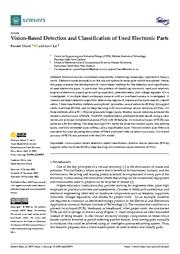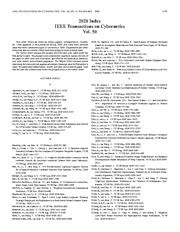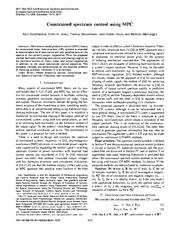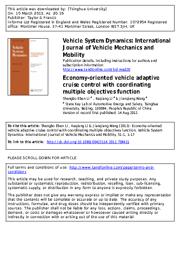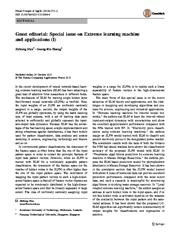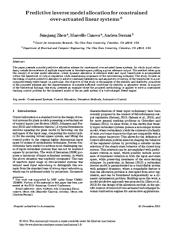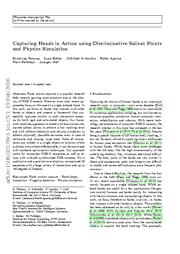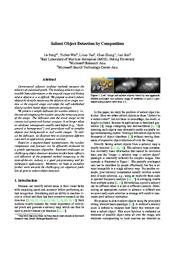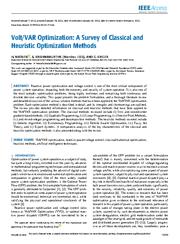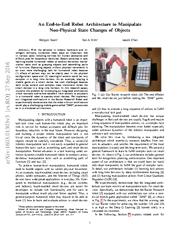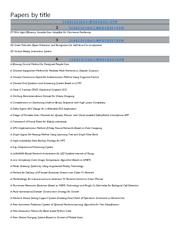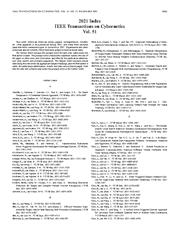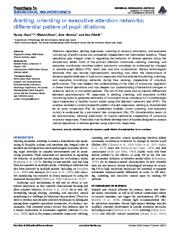A copy of this work was available on the public web and has been preserved in the Wayback Machine. The capture dates from 2022; you can also visit the original URL.
The file type is application/pdf.
Filters
Vision-Based Detection and Classification of Used Electronic Parts
2022
Sensors
A multiple object workspace scenario with an overhead camera is investigated. A customized object detection algorithm determines regions of interest and extracts data for classification. ...
Hence, this paper presents the development of vision-based methods for the detection and classification of used electronics parts. ...
Co-salient object detection distinguishes common and salient objects in a group of relevant images. ...
doi:10.3390/s22239079
pmid:36501783
pmcid:PMC9738186
fatcat:hcmxgxbbcnd7pf7jom6jwgnwmy
2020 Index IEEE Transactions on Cybernetics Vol. 50
2020
IEEE Transactions on Cybernetics
., Reference Trajectory Reshaping Optimi-zation and Control of Robotic Exoskeletons for Human-Robot Co-Manipulation; TCYB Aug. 2020 3740-3751 Wu, X., Jiang, B., Yu, K., Miao, c., and Chen, H ...
Xiao, S., +, TCYB March 2020 1220-1229 Linear quadratic control Reinforcement Learning-Based Linear Quadratic Regulation of Continuous-Time Systems Using Dynamic Output Feedback. ...
., +, TCYB Oct. 2020 4256-4267 ROSA: Robust Salient Object Detection Against Adversarial Attacks. ...
doi:10.1109/tcyb.2020.3047216
fatcat:5giw32c2u5h23fu4drupnh644a
Constrained spectrum control using MPC
2011
IEEE Conference on Decision and Control and European Control Conference
Well-known model predictive control (MPC) theory for constrained linear time-invariant (LTI) systems is extended to accommodate hard constraints and cost penalizations on the spectra of the system's output ...
Thus the proposed method facilitates enforcing constraints, and placing weights, on the harmonic content of input-, state-and output-trajectories, in addition to the usual constrained control objectives ...
For simplicity, the proposed constrained spectrum control problem setting, and solution strategy, is presented in this paper via the problem of linear-quadratic regulation (LQR), although the described ...
doi:10.1109/cdc.2011.6161381
dblp:conf/cdc/GondhalekarJBHM11
fatcat:76xm75ldkjesviodo56hbhfh5u
Economy-oriented vehicle adaptive cruise control with coordinating multiple objectives function
2013
Vehicle System Dynamics
In the framework of multi-objective coordination, this paper develops and experimentally validates an economy-oriented headway control algorithm for a passenger car with internal combustion engine. ...
The followed field tests show that, compared to a linear quadratic controller, such an algorithm improves both fuel economy and tracking capability while also being more responsive to driver car-following ...
A standard linear quadratic regulator (simply notated by LQ) is designed referring to [11] as a comparison. ...
doi:10.1080/00423114.2012.708421
fatcat:n3vk3daqzzg5rbjyrqsyzmjsfe
Guest editorial: Special issue on Extreme learning machine and applications (I)
2015
Neural computing & applications (Print)
The idea of uniformly randomly assigning input weights in a range for SLFNs is to realize such a linear separability of feature vectors in the high-dimensional feature space. ...
weights of the SLFN are globally optimized, by using the batch learning type of least squares, with a set of training data pairs selected to sufficiently and globally represent the inputand-output data ...
Experiment results on a public benchmark dataset have demonstrated that the proposed method can effectively segment the whole salient object with reasonable better performance and faster speed. ...
doi:10.1007/s00521-015-2086-6
fatcat:vo6m4zgqffdpzattdmfnzsoguu
Predictive inverse model allocation for constrained over-actuated linear systems
2016
Automatica
In support of the theoretical findings, this study presents an example where the proposed methodology is applied to solve a constrained tracking control problem for the linearized model of the air path ...
The method relies upon the concept of inverse model allocation, where dynamic allocation of reference state and input trajectories is accomplished within the framework of output regulation while maintaining ...
A standard linear quadratic regulator (LQR) approach has been used to design the stabilizing feedback gain K c = (C c D c ). ...
doi:10.1016/j.automatica.2016.01.045
fatcat:xinq2zzttbaj5lmdlsrsve345u
Capturing Hands in Action Using Discriminative Salient Points and Physics Simulation
2016
International Journal of Computer Vision
Our framework combines a generative model with discriminatively trained salient points to achieve a low tracking error and with collision detection and physics simulation to achieve physically plausible ...
In this work, we focus on hands that interact with other hands or objects and present a framework that successfully captures motion in such interaction scenarios for both rigid and articulated objects. ...
While isolated hands are useful for a few applications like gesture control, humans use hands mainly for interacting with the environment and manipulating objects. ...
doi:10.1007/s11263-016-0895-4
fatcat:xjo453uobfajrfesnvap34472u
Salient object detection by composition
2011
2011 International Conference on Computer Vision
We propose to detect salient objects by directly measuring the saliency of an image window in the original image and adopt the well established sliding window based object detection paradigm. ...
Moreover, we hope to stimulate further work towards the challenging yet important problem of generic salient object detection. ...
We propose to detect salient objects using the principled sliding window based paradigm [15] . A window's saliency score is defined to measure how likely this window contains a salient object. ...
doi:10.1109/iccv.2011.6126348
dblp:conf/iccv/FengWTZS11
fatcat:tpepced2rbbqfkejnvmle2mhru
Volt/VAR Optimization: A Survey of Classical and Heuristic Optimization Methods
2022
IEEE Access
The classical methods reviewed include (i) first-and second-order gradient-based methods, (ii) Quadratic Programming, (iii) Linear Programming, (iv) Interior-Point Methods, (iv) and mixed-integer programming ...
A comparative analysis of the key characteristics of the classical and heuristic optimization methods is also presented along with the review. ...
[86] . 3) QUADRATIC PROGRAMMING Quadratic Programming (QP) is a special case of nonlinear programming in which the objective function is quadratic and the constraint set is linear. ...
doi:10.1109/access.2022.3146366
fatcat:y5pt7ud5czgvhaw6ev24gsi3sy
An End-to-End Robot Architecture to Manipulate Non-Physical State Changes of Objects
[article]
2016
arXiv
pre-print
Recent advances in task learning enable humanoid robots to conduct dexterous manipulation tasks such as grasping objects and assembling parts of furniture. ...
as in a simulated environment. ...
Linear Quadratic Regulator Models LQR solves feedback control problems where the system dynamics is composed of linear differential equations and the cost is represented as a quadratic function, called ...
arXiv:1603.01303v3
fatcat:abxqjpkz6zctlc2kejom22maye
A simulation-based comparative analysis of PID and LQG control for closed-loop anesthesia delivery
[article]
2020
arXiv
pre-print
linear control strategies: proportional-integral-derivative (PID) control, linear quadratic Gaussian (LQG) control, and an LQG with integral action (ILQG). ...
Since control strategies for CLAD vary across the systems reported in recent literature, a comparative analysis of common control strategies can be useful. ...
To incorporate a linear feedback control framework to regulate y around a steady state value, characterized by the tuple (y ss , x ss , u ss ), we linearize Eq. (3) about this steady state, y − y ss = ...
arXiv:1912.06724v3
fatcat:ndcvzz7nvvdgdfl6z4tl2hdcke
Papers by Title
2019
2019 IEEE International Conference on Consumer Electronics - Taiwan (ICCE-TW)
Healthcare Data Exchange
RBF Neural Network Sliding Mode Control for Doubly Salient Electromagnetic Generator System
Real-Time Face Detection Method Using Wavelet-Based for a Beautification System ...
: A Brief Study
R 2 3 A B C D E F G H I L M N O P Q R S T U V W
Rat grooming detection using random forest classifier
RBAC-HDE: On the Design of a Role-based Access Control with Smart Contract for ...
doi:10.1109/icce-tw46550.2019.8991721
fatcat:62376ymadzge3g5xomicr5tesq
Sense and avoid technology developments at Queensland University of Technology
2016
IEEE Aerospace and Electronic Systems Magazine
The remaining degrees of freedom were then controlled separately using a series of Proportional-Integral-Derivative and/or Linear Quadratic Regulator controllers, resulting in a partitioned control approach ...
rates) could be regulated using a low-level autopilot. ...
doi:10.1109/maes.2016.150157
fatcat:qryueh23sbfjzizv7thjpboe4a
2021 Index IEEE Transactions on Cybernetics Vol. 51
2021
IEEE Transactions on Cybernetics
Correlation Depthwise Nonlocal Module for Fast Salient Object Detection Using a Single Thread. ...
Li, Z., +, TCYB July 2021 3441-3454 Depthwise Nonlocal Module for Fast Salient Object Detection Using a Single Thread. ...
doi:10.1109/tcyb.2021.3139447
fatcat:myjx3olwvfcfpgnwvbuujwzyoi
Alerting, orienting or executive attention networks: differential patters of pupil dilations
2013
Frontiers in Behavioral Neuroscience
The analysis revealed a construct-specific pattern of pupil responses: alerting is characterized by an early component (Pa), its acceleration enables covert orienting, and executive control is evidenced ...
by a prominent late component (Pe). ...
These differences increased as a function of condition within networks (p < 0.001) and as a function of network in both a linear fashion (p < 0.001) and a quadratic fashion (p < 0.039). ...
doi:10.3389/fnbeh.2013.00145
pmid:24133422
pmcid:PMC3796264
fatcat:4bchgymrcvahblza63hra4tkfi
« Previous
Showing results 1 — 15 out of 2,524 results

